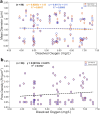Development of a new software for pore measurements in foraminifera and the constraints of pore proxy under high oxygen conditions
- PMID: 40025205
- PMCID: PMC11873220
- DOI: 10.1038/s41598-025-91821-3
Development of a new software for pore measurements in foraminifera and the constraints of pore proxy under high oxygen conditions
Abstract
The rise in anthropogenic activities has significantly increased nutrient input into coastal habitats, such as lagoons and estuaries. This has led to increased eutrophication, which has considerably decreased the oxygen concentration in the aquatic systems. The pore patterns in benthic foraminifera have become a reliable proxy for accurately estimating the changes in these past oxygen conditions. However, there is currently no specific platform for a proxy study that can adequately quantify these pore structures and meet the requirements for pore image analysis in foraminifera. This study presents the new indigenously developed software MicroFoss42, specifically tailored for the pore morphometrics in foraminifera. It integrates computer vision and artificial intelligence to seamlessly extract the pore data from the images. Here, we demonstrate its use in measuring the pore count, diameter, area and circularity index of Ammonia parkinsoniana. Our results agree with the manual analysis, differing by less than 7.5%. This semi-automated software is designed to facilitate rapid analysis of the pore patterns in any foraminiferal species without the need for any prior datasets for training. Moreover, this study shows that the practical application of foraminiferal pore proxy in high oxygen conditions may be constrained.
Keywords: Benthic foraminifera; Computer vision; Dissolved oxygen; MicroFoss42; Pores.
© 2025. The Author(s).
Conflict of interest statement
Declarations. Competing interests: The authors declare no competing interests.
Figures






References
-
- Schmidtko, S., Stramma, L. & Visbeck, M. Decline in global oceanic oxygen content during the past five decades. Nature542, 335–339 (2017). - PubMed
-
- Hoogakker, B. et al. Reviews and syntheses: review of proxies for low-oxygen paleoceanographic reconstructions. EGUsphere2024, 1–154 (2024).
-
- Stramma, L., Johnson, G. C., Sprintall, J. & Mohrholz, V. Expanding oxygen-minimum zones in the tropical oceans. Science320, 655–658 (2008). - PubMed
-
- Stramma, L., Schmidtko, S., Levin, L. A. & Johnson, G. C. Ocean oxygen minima expansions and their biological impacts. Deep Sea Res. Part. I: Oceanogr. Res. Pap. 57, 587–595 (2010).
-
- Keeling, R. F., Körtzinger, A. & Gruber, N. Ocean deoxygenation in a warming world. Annu. Rev. Mar. Sci.2, 199–229 (2010). - PubMed
Grants and funding
LinkOut - more resources
Full Text Sources
Miscellaneous

